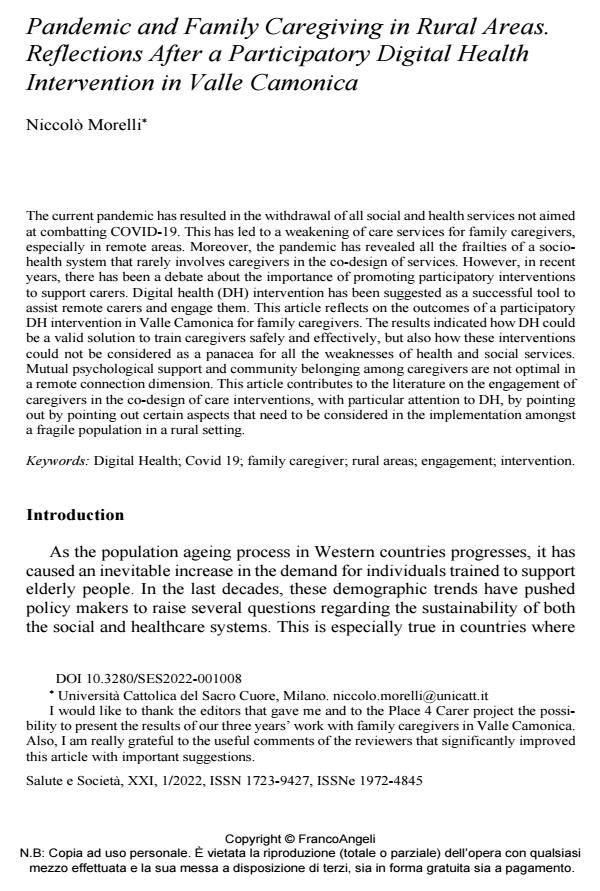Pandemic and Family Caregiving in Rural Areas. Reflections After a Participatory Digital Health Intervention in Valle Camonica
Journal title SALUTE E SOCIETÀ
Author/s Niccolò Morelli
Publishing Year 2022 Issue 2022/1
Language English Pages 15 P. 113-127 File size 220 KB
DOI 10.3280/SES2022-001008
DOI is like a bar code for intellectual property: to have more infomation
click here
Below, you can see the article first page
If you want to buy this article in PDF format, you can do it, following the instructions to buy download credits

FrancoAngeli is member of Publishers International Linking Association, Inc (PILA), a not-for-profit association which run the CrossRef service enabling links to and from online scholarly content.
The current pandemic has resulted in the withdrawal of all social and health services not aimed at combatting COVID-19. This has led to a weakening of care services for family caregivers, especially in remote areas. Moreover, the pandemic has revealed all the frailties of a socio-health system that rarely involves caregivers in the co-design of services. However, in recent years, there has been a debate about the importance of promoting participatory interventions to support carers. Digital health (DH) intervention has been suggested as a successful tool to as-sist remote carers and engage them. This article reflects on the outcomes of a participatory DH intervention in Valle Camonica for family caregivers. The results indicated how DH could be a valid solution to train caregivers safely and effectively, but also how these interventions could not be considered as a panacea for all the weaknesses of health and social services. Mutual psychological support and community belonging among caregivers are not optimal in a remote connection dimension. This article contributes to the literature on the engagement of caregivers in the co-design of care interventions, with particular attention to DH, by pointing out by pointing out certain aspects that need to be considered in the implementation amongst a fragile population in a rural setting.
Keywords: Digital Health; Covid 19; family caregiver; rural areas; engagement; intervention.
- Active ageing in marginal areas: a scoping review Rebecca Paraciani, Emma Garavaglia, in SOCIOLOGIA URBANA E RURALE 137/2025 pp.24
DOI: 10.3280/SUR2025-137002
Niccolò Morelli, Pandemic and Family Caregiving in Rural Areas. Reflections After a Participatory Digital Health Intervention in Valle Camonica in "SALUTE E SOCIETÀ" 1/2022, pp 113-127, DOI: 10.3280/SES2022-001008